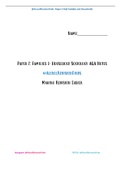@ALevelRevisionFinds- Paper 2 AQA Families and Households
Name:____________
Paper 2: Families & Household Sociology AQA Notes
@AlevelRevisionFinds
Making Revision Easier
Instagram: @AlevelRevisionFinds TIKTOK: @AlevelRevisionFinds
, @ALevelRevisionFinds- Paper 2 AQA Families and Households
How to Use This Revision Guide?
MUST BE PRINTED IN COLOUR TO USE EFFECTIVELY
Pink: Name Of Sociologist “*”Indicates Key Sociologist
Dark Blue: Key Studies or Key Information
Purple: Key Term/Word
Red: A03: Limitation/Weakness of Theory
Green: A03: Strength/Weakness of Theory
Use the Contents to guide your revision, Revise Topics You Find Most
Difficult!
Highlight any Key Terms you don’t understand, feel free to DM or Email for
any additional A* support, Details can be found on the footer of page :)
Use the evaluation carefully to make your answer analytically correct, only
one evaluation point per point (Try to use a limitation rather than a strength)
USE CLEAR PEEL STRUCTURE: Point, Explain, Evaluation, Link
E.g. Item A states (Point), For Example (Sociologist), However (Evaluation),
Link (This shows that…)
Follow these tips and it will guarantee you an A*
Good Luck!!
Instagram: @AlevelRevisionFinds TIKTOK: @AlevelRevisionFinds
, @ALevelRevisionFinds- Paper 2 AQA Families and Households
Paper 2- Families and Households
Topics:
− Couples:
♦ Domestic division of labour
♦ Equality within couples?
♦ Resources management and Decision-making
♦ Domestic Violence
− Theories of the family:
♦ Functionalist, Marxist, Feminist, Personal life perspective (PLP)
− Demography:
♦ Birth rate
♦ Deaths
♦ Ageing population
♦ Migration and Globalisation
− Childhood:
♦ Social construction of childhood
♦ Future of childhood
♦ Has the position of children improved?
− Changing family patterns:
♦ Divorce
♦ Changes to Marriage & Partnerships
♦ Changes to Children & Families
♦ Ethnic differences in family patterns
♦ The Extended family today
− Family diversity:
♦ Modernism and the nuclear family
♦ Post-Modernism and family diversity
− Families and Social Policy:
♦ A comparative view of family policy
♦ Perspectives on families and social policy
Instagram: @AlevelRevisionFinds TIKTOK: @AlevelRevisionFinds
, @ALevelRevisionFinds- Paper 2 AQA Families and Households
Topic 1: Couples
The Domestic Division of Labour
Domestic division of labour: The roles that men and women play in relation to housework,
childcare and paid work.
In the traditional nuclear family, roles between the husband and wife are segregated, Parsons
says there is a clear division of labour in the family.
➢ Husband- INSTRUMENTAL ROLE- working full-time to provide for the family.
(Breadwinner)
➢ Wife- EXPRESSIVE ROLE- full-time housewife, meeting emotional needs of the family
and fulfilling primary socialisation.
*Parsons argues that the division is based on biological differences- Women seen as more
nurturing and men as the provider. He claims this division of labour is beneficial to the family
and wider society.
Criticisms of Parson’s view:
− *Wilmott & Young (Symmetrical family)- Men share more domestic tasks as more wives
become wage earners.
− Feminists- reject Parson’s view that the division of labour is natural and argue that it
only benefits men.
*BOTT- Joint and Segregated conjugal roles:
➢ Segregated conjugal roles- couple have separate roles (Male= Breadwinner, female=
Housewife). Leisure time is also separate.
➢ Joint conjugal roles- couples share tasks e.g. housework, childcare, leisure time.
♦ Key study: Young & Wilmott (Bethnal Green)
They found a pattern of segregated conjugal roles in traditional working- class extended families
in the 1950’s. Men= Breadwinners, didn’t do much housework, and spent leisure time in pubs
with their workmates. Women were full-time housewives, limited leisure time spent with other
female members of the family.
Wilmott & Young- The Symmetrical family:
➢ ‘March of progress’ view, family life gradually improving for all members, more equal over-
time.
➢ Symmetrical family- a family where the roles between husband and wife are much more
similar.
3 key changes:
▪ Women go out to work.
▪ Men now help with housework and childcare.
▪ Couples now spend leisure time together.
Instagram: @AlevelRevisionFinds TIKTOK: @AlevelRevisionFinds





